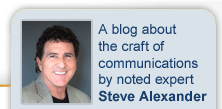| |
| |
Archive for March, 2010
Posted March 29th, 2010 by Steve Alexander
If you don’t have Corner Office set up for your Sunday morning New York Times read, you’re missing out on a great column and an opportunity to become a more effective leader. It doesn’t matter whether you’re the CEO, just getting started in a new career or anywhere along the way. For that matter, you’ll find the insights valuable and applicable for life in general.
Columnist Adam Bryant conducts interviews of top leaders and explores provocative, interesting, insightful topics that mine the perspectives of these CEOs and top industry executives. These are challenging times, and finding new views, effective tools, insights from the experts and the candid comments from those who have learned lessons from real-world experience is worth the few minutes you’ll invest.
More than that, make it a point to find a lesson in each interview, something that you can apply yourself or pass along to someone you know who can benefit. And be sure to check out the blogs for lively debate on the range of issues you’ll discover from your read.
Simple. Easy. And I guarantee you’ll find something useful within the first few doses!
Posted March 18th, 2010 by Steve Alexander
That quote is from Dr. Mimi Guarneri’s book, “The Heart Speaks.” If you haven’t read it, get it today. It came as a promotional on my new e-Reader and I thought, I’ll give it a try. Dr G, as she’s referred to by most of her patients, is a specialist in stents, however, more importantly, has uncovered and shares secrets that all of us can use in our lives every day.
She goes on to write, “Research now suggests that it [gratefulness] also allows people to deal better with stress, causing them to be more optimistic, which seems to boost immune function.” Now, how can you argue with those “side effects” from taking the time in your own life to take stock, identify something or someone to be thankful for, and get a little immunity protection along the way?
Oh, and on optimism, try this on for size: “In one study, patients who described themselves as highly optimistic had lower risks of all-cause death and lower rates of cardiovascular death than those with high levels of pessimism.” Wouldn’t it be great to be able to get that in capsule form as well as tablets? Take one capsule of optimism three times a day with each meal!
So, why do we focus so much on the negative in our lives? What keeps us from being optimistic and grateful? Her book provides numerous patient profiles as well as studies and statistics that will give you insights and answers. For anyone committed to healthy living (emotionally and physically!), you really should check it out. As in an earlier post I wrote, there’s really not a lot of effort in noticing the good in others, taking the time to be thankful for even the small things that come into our lives each day.
We just need that daily reminder (in capsule or tablet form!) that the alternative can be very costly to our physical health. So, share a smile with someone when you’re done reading this post today; pick up the phone and re-connect with an old friend or family member; thank a co-worker for something that usually goes unnoticed. It’s contagious, infectious and healthy.
Our attitudes really do shape our health and wellness. “The Heart Speaks” will stimulate your thinking and, hopefully, your behavior, so that each day makes a difference in your and someone else’s life. And if that makes your heart healthier, how can you lose?
Posted March 13th, 2010 by Steve Alexander
I recently attended a seminar on employee motivation, team-building and coaching, looking for some additional, new tips and reminders for my coaching work with leaders and teams. I was struck by this simple phrase, “What gets rewarded, gets repeated!” It reminded me of my early days as a young pup working on my bachelor’s degree in psychology. B.F. Skinner’s theory about rewarding behavior is easily summarized in that phrase. Yet, too often we forget it. And when we forget to acknowledge how much we appreciate our co-workers, and others in our lives who matter to us, as a result we see our teams, co-workers, the workplace, even our own relationships slip into mediocrity. Folks end up “just putting in the time.”
On a recent vehicle purchase, when the person who handled the transaction went above-and-beyond my expectations (this during the swirl of media about problems with Toyotas), I made sure I completed the customer satisfaction survey, and that they got complimented for their extraordinary effort. Sure, it took a few minutes to complete the survey (we get most of them on-line these days, so they’re easy to do… and also easy to ignore). It does take something from us to extend that compliment, the notice and thanks for someone who took the time to care. Was it worth it?
When I got the call that the survey was mentioned at a staff meeting, and this professional beamed with satisfaction for the recognition, I knew it mattered. And it was worth it.
If we want folks to show up on time and be prepared, thank them when they do. If someone’s gone the extra mile, find a way to call it out… to them and to others. Build into your teams and your work day the opportunities to reward and recognize the kind of behavior you want. It’s easy to fall into the habit of simply taking it for granted.
So, next time someone does something worth noticing, notice it. The cost of a compliment is inexpensive. The results… priceless.
Posted March 4th, 2010 by Steve Alexander
“We’re going to have to let you go.”
I remember my first experience in my early 20s when I supervised a small crew and had to face an employee to let him know his employment was going to end. As clear as it was that it was the right step, executing the decision was tough. It’s personal. To the person who hears those words. No matter what. So, a few key thoughts for your consideration and use.
1) Hire slow, fire fast! – The most important strategy is to make sure you have the right people in the first place. To borrow from Jim Collins in “Good to Great,” the most important decision a CEO/leader can make is to put the right people on the bus in the right seats, and to get the wrong people off the bus. Great companies with effective leaders, according to Collins, make these kinds of decisions early in their tenure and the benefits endure. No seat is expendable for other than fully committed, loyal, passionate people who are dedicated to the company’s mission and vision, and want to contribute to its success. Invest your time wisely finding them (that means days of interviews, not an hour!) and the pay-off will be exponential.
2) Compassionate, well-conducted exit interviews can actually be beneficial to both the organization and the departing individual. – I was called in once to assess a situation on behalf of a board executive committee who knew it had a problem with staff leadership and didn’t know how to proceed. After careful interviews with the entire staff, including the chief executive, selected board members and some external audiences, it was apparent there was a bad fit for the organization and its CEO, even though, on the surface, her qualifications, intelligence, enthusiasm and desire to succeed were remarkable. A decision was made that saved the organization (staff were beginning to leave, board members were disillusioned, etc.) and gave the departing CEO the opportunity to assess her own goals and identify opportunities that were a much better fit for ultimate success.
On a final note, if you’ve seen the movie, “Up in the Air,” one of this year’s Oscar nominees for George Clooney’s performance as the consummate “hatchet man,” you can understand the devastating impact the words, “We’re letting you go,” can have. (It’s hard to believe we popularize a TV show with the title, “You’re Fired!”) What most don’t know is that Jason Reitman, the film’s director, with whom we met during a Cinema Society of San Diego screening (a shout-out to Andy Friedenberg for running one of the great organizations!), explained that the interviews conducted at the opening and closing sequences were of real people (one notable exception) responding to their own employment termination. The filming of the movie started before the economic downturn, and yet becomes very timely given today’s challenges. According to Reitman, those same folks were given an opportunity to express themselves and what they would have liked to have said had they had a chance to do it again. You’ll see those scenes during the closing credits. It’s a real eye-opener and education for anyone who ever has to say those words.
Tough as is it sometimes, making the right decision (and taking the time) to hire the right people for the right positions in the first place, and then moving timely and compassionately when you have to move people off the bus, will serve your organization well. And guarantee enduring results.
Return to Top
|
|
|
|




